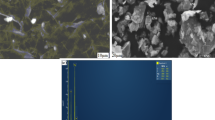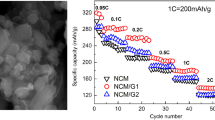Abstract
The graphene-supported WS2 composite (WS2-G) was synthesized by the ultra-sonication method. X-ray diffraction (XRD), X-ray photoelectron spectroscopy (XPS), and field emission scanning electron microscopy (FESEM) showed WS2 had been successfully combined with the graphene. The charge-discharge tests, cyclic voltammetry, and electrochemical impedance spectroscopy were used to study electrochemical properties of as-synthesized composite material. The results showed that the electrochemical properties of graphene-supported WS2 were superior to that of WS2 material. The initial discharge capacity of the graphene-supported WS2 material reached 82 mAh g−1. After 100 cycles, it still had a capacity retention rate of 95%. Enhanced electrochemical performance of graphene-supported WS2 could be attributed due to the synergistic effect between WS2 and highly conductive graphene. The intercalation behavior of Mg2+ is further confirmed by XRD, EDX, and XPS analysis.









Similar content being viewed by others
References
Yoo HD, Shterenberg I, Gofer Y, Gershinsky G, Pour N, Aurbach D (2013) Mg rechargeable batteries: an on-going challenge. Energy Environ Sci 6:2265–2279
Matsui M (2011) Study on electrochemically deposited Mg metal. J Power Sources 196:7048–7055
Park M-S, Kim J-G, Kim Y-J, Choi N-S, Kim J-S (2015) Recent advances in rechargeable magnesium battery technology: a review of the field’s current status and prospects. Isr J Chem 55:570–585
Amir N, Vestfrid Y, Chusid O, Gofer Y, Aurbach D (2007) Progress in nonaqueous magnesium electrochemistry. J Power Sources 174:1234–1240
Aurbach D, Gofer Y, Lu Z, Schechter A, Chusid O, Gizbar H, Cohen Y, Ashkenazi Y, Moshkovich M, Turgeman R, Levi E (2001) A short review on the comparison between Li battery systems and rechargeable magnesium battery technology. J Power Sources 97-98:28–32
Lu Z, Schechter A, Moshkovich M, Aurbach D (1999) On the electrochemical behavior of magnesium electrodes in polar aprotic electrolyte solutions. J Electroanal Chem 466:203–217
Levi E, Gofer Y, Vestfreed Y, Lancry E, Aurbach D (2002) Cu2Mo6S8 Chevrel phase, a promising cathode material for new rechargeable Mg batteries: a mechanically induced chemical reaction. Chem Mater 14:2767–2773
Levi E, Lancry E, Gofer Y, Aurbach D (2006) The crystal structure of the inorganic surface films formed on Mg and Li intercalation compounds and the electrode performance. J Solid State Electrochem 10:176–184
Minakshi M, Mitchell DRG, Munnangi AR, Barlow AJ, Fichtner M (2018) New insights into the electrochemistry of magnesium molybdate hierarchical architectures for high performance sodium devices. Nanoscale 10(27):13277–13288
Li X-L, Li Y-D (2004) MoS2 nanostructures: synthesis and electrochemical Mg2+ intercalation. J Phys Chem B 108:13893–13900
Liang Y, Feng R, Yang S, Ma H, Liang J, Chen J (2011) Rechargeable Mg batteries with graphene-like MoS2 cathode and ultrasmall Mg nanoparticle anode. Adv Mater 23:640–643
Matte HSSR, Gomathi A, Manna AK, Late DJ, Datta R, Patti SK, Rao CNR (2010) MoS2 and WS2 analogues of graphene. Angew Chem Int Ed 49:4059–4062
Teo WZ, Chng ELK, Sofer Z, Pumera M (2014) Cytotoxicity of exfoliated transition-metal dichalcogenides (MoS2, WS2, and WSe2) is lower than that of graphene and its analogues. Chem Eur J 20:9627–9632
Zou ML, Zhang JF, Zhu H, Du ML, Wang QF, Zhang M, Zhang XW (2015) A 3D dendritic WSe2 catalyst grown on carbon nanofiber mats for efficient hydrogen evolution. J Mater Chem A 3:12149–12153
Bindumadhavan K, Srivastava SK, Mahanty S (2013) MoS2- MWCNT hybrids as a superior anode in lithium-ion batteries. Chem Commun 49:1823–1825
Liu Y, Wang W, Huang H, Gu L, Wang Y, Peng X (2014) The highly enhanced performance of lamellar WS2 nanosheet electrodes upon intercalation of single-walled carbon nanotubes for supercapacitors and lithium ions batteries. Chem Commun 50:4485–4488
Voiry D, Yamaguchi H, Li J, Silva R, Alves DCB, Fujita T, Chen M, Asefa T, Shenoy VB, Eda G, Chhowalla M (2013) Enhanced catalytic activity in strained chemically exfoliated WS2 nanosheets for hydrogen evolution. Nat Mater 12:850–855
Duan JJ, Chen S, Chambers BA, Andersson GG, Qiao SZ (2015) 3D WS2 nanolayers@heteroatom-doped graphene films as hydrogen evolution catalyst electrodes. Adv Mater 27:4234–4241
Ambrosi A, Sofer Z, Pumer M (2015) 2H-1T phase transition and hydrogen evolution activity of MoS2, MoSe2, WS2 and WSe2 strongly depends on the MX2 composition. Chem Commun 51:8450–8453
Zhang J, Wang Q, Wang LH, Li X, Huang W (2015) Layer controllable WS2-reduced graphene oxide hybrid nanosheets with high electrocatalytic activity for hydrogen evolution. Nanoscale 7:10391–10397
Chen R, Zhao T, Wu W, Wu F, Li L, Qian J, Xu R, Wu H, Albishri HM, Al-Bogami AS, El-Hady DA, Lu J, Amine K (2014) Free-standing hierarchically sandwich-type tungsten disulfide nanotubes/graphene anode for lithium-ion batteries. Nano Lett 14:5899–5904
Li H, Yu K, Hao F, Guo B, Lei X, Zhu Z (2015) Multi-slice nanostructured WS2@rGO with enhanced Li-ion battery performance and a comprehensive mechanistic investigation. Phys Chem Chem Phys 17:29824–22983
Xu XD, Rout CS, Yang J, Cao RG, Oh P, Shin HS, Cho J (2013) Freeze-dried WS2 composites with low content of graphene as high-rate lithium storage materials. J Mater Chem A 1:14548–14554
Dawei S, Dou S, Wang G (2014) WS2@graphene nanocomposites as anode materials for Na-ion batteries with enhanced electrochemical performances. Chem Commun 50:4192–4195
Liu Y, Fan L-Z, Jiao L (2017) Graphene intercalated in graphene-like MoS2: a promising cathode for rechargeable Mg batteries. J Power Sources 340:104–110
Konda S, Ramakrishna Matte HSS, Rajendra HB, Bhattacharyya AJ, Rao CNR (2013) Employing synergistic interactions between few-layer WS2 and reduced graphene oxide to improve lithium storage, cyclability and rate capability of Li-ion batteries. Nano Energy 2:787–793
Yang W, Lu H, Cao Y, Xu B, Deng Y, Cai W (2019) Flexible free-standing MoS2/carbon nanofibers composite cathode for rechargeable aluminum-ion batteries. ACS Sustain Chem Eng 7:4861–4867
Aurbach D, Lu Z, Schechter A, Gofer Y, Gizbar H, Turgeman R, Cohen Y, Moshkovich M, Levi E (2000) Prototype systems for rechargeable magnesium batteries. Nature 407:724–727
Doe RE, Han R, Hwang J, Gmitter AJ, Shterenberg I, Yoo HD, Aurbach NPD (2014) Novel, electrolyte solutions comprising fully inorganic salts with high anodic stability for rechargeable magnesium batteries. Chem Commun 50:243–245
Liu T, Shao Y, Li G, Meng G, Hu J, Xu S, Nie Z, Chen X, Wang C, Liu J (2014) A facile approach using MgCl2 to formulate high performance Mg2+ electrolytes for rechargeable Mg batteries. J Mater Chem A 2:3430–3438
Barile CJ, Barile EC, Zavadil KR, Nuzzo RG, Gewirth AA (2014) Electrolytic conditioning of a magnesium aluminum chloride complex for reversible magnesium deposition. J Phys Chem C 118:27623–27630
Chen Q, Liu H, Hao J, Bi S, Chen L (2018) Synthesis and characterization of high performance RGO-modified LiNi0.5Mn1.5O4 nanorods as a high power density cathode material for Li-ion batteries. Ionics 25:1–11
Zhou X, Wang F, Zhu Y, Liu Z (2011) Graphene modified LiFePO4 cathode materials for high power lithium-ion batteries. J Mater Chem 21:3353–3358
Malyala L, Thatipamula S, Jetti V (2019) Magnesium–graphene composite coated on SS mesh as cathode material for rechargeable magnesium ion battery. Trans Indian Inst Metals 72:2503–2510
Liu N, Luo F, Wu H, Liu Y, Zhang C, Chen J (2008) One-step ionic-liquid-assisted electrochemical synthesis of ionic-liquid-functionalized graphene sheets directly from graphite. Adv Funct Mater 18:1518–1525
Mao X, Xu Y, Xue Q, Wang W, Gao D (2013) Ferromagnetism in exfoliated tungsten disulfide nanosheets. Nanoscale Res Lett 8:430
Zhang P, Qin F, Zou L, Wang M, Zhang K, Lai Y, Li J (2017) Few-layer MoS2/C with expanding d-spacing as high-performance anode for sodium ion batteries. Nanoscale 9(33):12189–12195
Majumder S, Shao M, Deng Y, Chen G (2019) Two dimensional WS2/C nanosheets as a polysulfides immobilizer for high performance lithium-sulfur batteries. J Electrochem Soc 166(3):A5386–A5395
Li H, Yu K, Li C, Zheng T, Guo B, Lei X, Hao F, Zhu Z (2015) Charge-transfer induced high efficient hydrogen evolution of MoS2/graphene cocatalyst. Sci Rep 5:18730
Zhang X, Xu H, Wang J, Ye X, Lei W, Xue M, Tang H, Li C (2016) Synthesis of ultrathin WS2 nanosheets and their tribological properties as lubricant additives. Nanoscale Res Lett 11:442
Liu Y, Jiao L, Wu Q, Zhao Y, Cao K, Liu H, Wang Y, Yuan H (2013) Synthesis of rGO-supported layered MoS2 for high-performance rechargeable Mg batteries. Nanoscale 5:9562
Liu S, Shen B, Niu Y, Xu M (2017) Fabrication of WS2-nanoflowers@rGO composite as an anode material for enhanced electrode performance in Lithium-ion batteries. J Colloid Interface Sci 488:20–25
Von Lim Y, Huang ZX, Wang Y, Fei Hu D, Zhang J, Chen TP, Ang LK, Yang HY (2016) WS2–3D graphene nano-architecture networks for high performance anode materials of lithium ion batteries. RSC Adv 6(109):107768–107775
Li X, Zai J, Xiang S, Liu Y, He X, Xu Z, Wang K, Ma Z, Qian X (2016) Regeneration of metal sulfides in the delithiation process: the key to cyclic stability. Adv Energy Mater 6:1601056
Hsu C-J, Chou C-Y, Yang C-H, Lee T-C, Chang J-K (2016) MoS2/graphene cathodes for reversibly storing Mg2+ and Mg2+/Li+ in rechargeable magnesium-anode batteries. Chem Commun 52:1701–1704
Liu B, Luo T, Guangyuan M, Wang X, Chen D, Shen G (2013) Rechargeable Mg-ion batteries based on WSe2 nanowire cathodes. ACS Nano 7(9):8051–8058
Huang HH, Shih WC, Lai CH (2010) Nonpolar resistive switching in the Pt/MgO/Pt nonvolatile memory device. Appl Phys Lett 96:193505-1–193505-3
Guo P, Liu D, Liu Z, Shang X, Liu Q, He D (2017) Dual functional MoS2/graphene interlayer as an efficient polysulfide barrier for advanced lithium-sulfur batteries. Electrochim Acta 256:28–36
Choi SH, Boo SJ, Lee J-H, Kang YC (2014) Electrochemical properties of tungsten sulfide–carbon composite microspheres prepared by spray pyrolysis. Sci Rep 4:5755
Funding
The authors received financial support from DRDO, India through CARS-381 project and the author M. Latha received financial support from CSIR-IICT (IICT/Pubs./2019/361) and CSIR via CSIR-SRF.
Author information
Authors and Affiliations
Corresponding author
Additional information
Publisher’s note
Springer Nature remains neutral with regard to jurisdictional claims in published maps and institutional affiliations.
Rights and permissions
About this article
Cite this article
Latha, M., Biswas, S. & Rani, J.V. Application of WS2-G composite as cathode for rechargeable magnesium batteries. Ionics 26, 3395–3404 (2020). https://doi.org/10.1007/s11581-020-03512-w
Received:
Revised:
Accepted:
Published:
Issue Date:
DOI: https://doi.org/10.1007/s11581-020-03512-w




